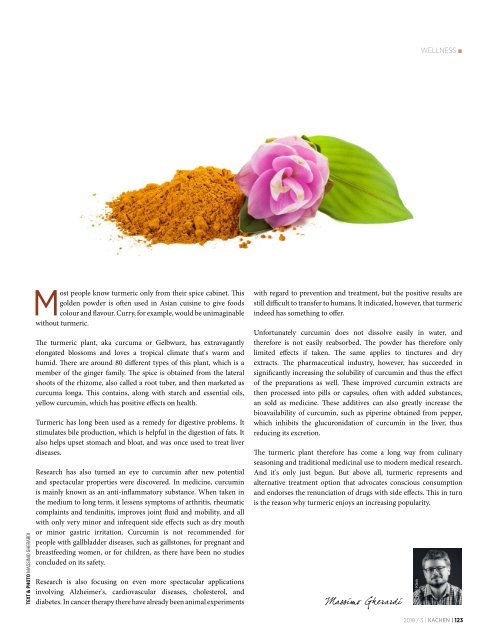KACHEN #16 (Autumn 2018) English edition
- No tags were found...
Create successful ePaper yourself
Turn your PDF publications into a flip-book with our unique Google optimized e-Paper software.
WELLNESS n<br />
TEXT & PHOTO MASSIMO GHERARDI<br />
Most people know turmeric only from their spice cabinet. This<br />
golden powder is often used in Asian cuisine to give foods<br />
colour and flavour. Curry, for example, would be unimaginable<br />
without turmeric.<br />
The turmeric plant, aka curcuma or Gelbwurz, has extravagantly<br />
elongated blossoms and loves a tropical climate that's warm and<br />
humid. There are around 80 different types of this plant, which is a<br />
member of the ginger family. The spice is obtained from the lateral<br />
shoots of the rhizome, also called a root tuber, and then marketed as<br />
curcuma longa. This contains, along with starch and essential oils,<br />
yellow curcumin, which has positive effects on health.<br />
Turmeric has long been used as a remedy for digestive problems. It<br />
stimulates bile production, which is helpful in the digestion of fats. It<br />
also helps upset stomach and bloat, and was once used to treat liver<br />
diseases.<br />
Research has also turned an eye to curcumin after new potential<br />
and spectacular properties were discovered. In medicine, curcumin<br />
is mainly known as an anti-inflammatory substance. When taken in<br />
the medium to long term, it lessens symptoms of arthritis, rheumatic<br />
complaints and tendinitis, improves joint fluid and mobility, and all<br />
with only very minor and infrequent side effects such as dry mouth<br />
or minor gastric irritation. Curcumin is not recommended for<br />
people with gallbladder diseases, such as gallstones, for pregnant and<br />
breastfeeding women, or for children, as there have been no studies<br />
concluded on its safety.<br />
Research is also focusing on even more spectacular applications<br />
involving Alzheimer's, cardiovascular diseases, cholesterol, and<br />
diabetes. In cancer therapy there have already been animal experiments<br />
with regard to prevention and treatment, but the positive results are<br />
still difficult to transfer to humans. It indicated, however, that turmeric<br />
indeed has something to offer.<br />
Unfortunately curcumin does not dissolve easily in water, and<br />
therefore is not easily reabsorbed. The powder has therefore only<br />
limited effects if taken. The same applies to tinctures and dry<br />
extracts. The pharmaceutical industry, however, has succeeded in<br />
significantly increasing the solubility of curcumin and thus the effect<br />
of the preparations as well. These improved curcumin extracts are<br />
then processed into pills or capsules, often with added substances,<br />
an sold as medicine. These additives can also greatly increase the<br />
bioavailability of curcumin, such as piperine obtained from pepper,<br />
which inhibits the glucuronidation of curcumin in the liver, thus<br />
reducing its excretion.<br />
The turmeric plant therefore has come a long way from culinary<br />
seasoning and traditional medicinal use to modern medical research.<br />
And it's only just begun. But above all, turmeric represents and<br />
alternative treatment option that advocates conscious consumption<br />
and endorses the renunciation of drugs with side effects. This in turn<br />
is the reason why turmeric enjoys an increasing popularity.<br />
© Marc Klein<br />
<strong>2018</strong> / 3 | <strong>KACHEN</strong> | 123


















